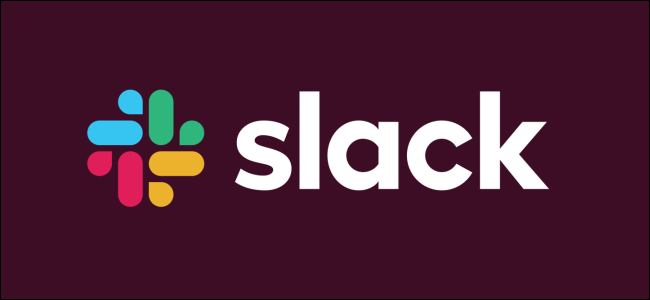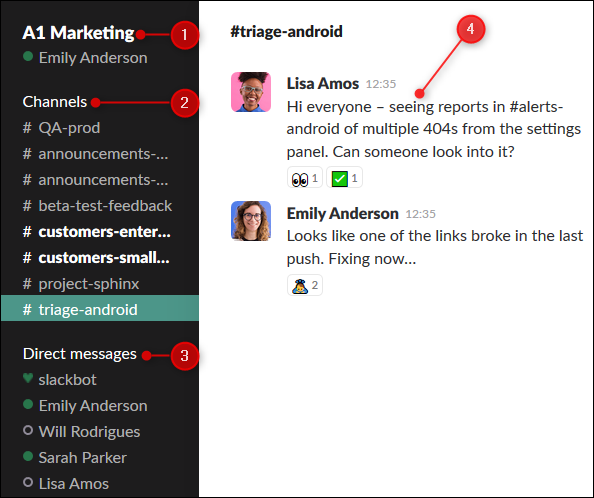Quick Links
Slack is a workplace chat app that's so popular, the company that owns it was valued at more than $20 billion. You've probably seen it mentioned in the news. If you haven't used it yet, here's what you need to know.
What is Slack?
Slack is a workplace communication tool, "a single place for messaging, tools and files." This means Slack is an instant messaging system with lots of add-ins for other workplace tools. The add-ins aren't necessary to use Slack, though, because the main functionality is all about talking to other people. There are two methods of chat in Slack: channels (group chat), and direct message or DM (person-to-person chat). Let's take a quick look at the user interface.
There are four main things to pay attention to in Slack:
- The name of the Slack instance.
- The list of channels you're a member of.
- The list of people you've direct messaged.
- The chat window.
When a customer wants to start using Slack, they choose a name for their Slack instance. This then becomes part of the unique URL. So, if Wile E. Coyote wants to create a Slack instance for ACME Slingshots, his Slack instance would be https://acmeslingshot.slack.com/. Wile E. can then invite anyone he wants to be a member of his Slack instance.
Channels in Slack can be public, meaning any member can see and join that channel, or private, meaning only members of that channel can see it or invite others to join. DMs are always private, although they can include up to 8 people.
The chat window is where all the actual communication happens. You can read any reply to messages, use emoji reactions, add gifs, see RSS feeds, set reminders, get add-in notifications, and various other bells and whistles. But more than anything, this is where you talk to people.
What's So Great About Slack?
When Slack came along, there were no real competitors in the market. That's not to say there weren't other chat apps, but Slack combined an intuitive UI with both group and person-to-person messaging. It also allows companies to have a measure of control over who can use it through the invitation system. Other tools could do the same, but without the same usability (Campfire, now BaseCamp, was an obvious one). None of the traditional vendors (Microsoft, Apple, IBM, Sun, and so on) had anything comparable to Slack.
This lack of corporate size was also a benefit. Slack was small enough to be responsive and quick when it came to adding new features, like emoji reactions (great for users) and 2-factor authentication (great for admins). For some users, the fact that Slack wasn't owned by a big traditional vendor was benefit enough, but that doesn't explain why Slack is so popular.
Slack does two things really well: design and understanding its users' needs. These twin pillars are the basis of most good products but are surprisingly difficult to do well, as many a failed app will prove. The rough initial design was created by Slack founder, Stewart Butterfield (the same guy who co-founded Flickr back in the early 2000s) and his team, and then given to a third party called MetaLab to polish. Andrew Wilkinson from MetaLab explained:
"To get attention in a crowded market, we had to find a way to get people’s attention. Most enterprise software looks like a cheap 70's prom suit---muted blues and greys everywhere---so, starting with the logo, we made Slack look like a confetti cannon had gone off. Electric blue, yellows, purples, and greens all over. We gave it the color scheme of a video game, not an enterprise collaboration product...vibrant colors, a curvy sans-serif typeface, friendly icons, and smiling faces and emojis everywhere."
In the same article, Wilkinson talks about how well-built Slack feels when you use it---which it does---and how the content, such as loading messages, is informal and often pretty funny, concluding, "It’s the same enterprise chat client underneath, but it’s playful, fun to use, and all that comes together to make it feel like a character in your life."
When you look at the elements that comprise Slack, the ease of use, and reliability stand out. It's easy for non-technical users to pick up, especially when compared to other group chat tools, like Basecamp or Microsoft Teams. Also, you can spin up your own Slack instance for free, even for personal use. And if you don't like the "confetti cannon" look, it's easy to change the colors.
But good design is not of much use if the functionality isn't there. Chat is relatively easy to do, which is why most chat apps follow the same basic format: a window to view the conversation, and a place to type, either underneath or on the side. This is where Slack's attention to the requirements of its users comes into play. Rather than reinvent the chat wheel, they focused on what people wanted from a chat app over and above the basic requirement of sending messages to each other.
One of Slack's most prominent selling points was that private channels and DMs couldn't be read by Slack administrators without either the open consent of the members or a message being sent to all the users saying that an export of messages had happened. This gave a sense of privacy and security to users that other products (especially email) didn't.
Thanks primarily to the GDPR legislation that came into force in Europe in 2018, though, this has changed---administrators on the higher-cost tiers can do a full export without informing their users. This shows how strongly many users valued the original privacy settings, a good demonstration of how---when not constrained by legislation---Slack understands what its users want.
They gain this understanding mainly by using the product themselves every day:
"[W]ithin the walls of Slack HQ in San Francisco, the design team can test different user scenarios with its own departments. Each department acts as a microcosm of the larger customer base. For example, designers can learn more about how to improve Slack for finance teams by observing and gathering feedback from its own finance department."
As one of their product designers says in the same article: "User feedback is also regularly trickling in from outside of the company, and everyone serves weekly support shifts to better empathize with customers."
How many companies do you know where everyone has to work a regular shift in support to make sure they understand customer pain points?
Slack also decided early on to push an ecosystem of app integrations. Users can integrate almost any app they want, from dev tools, like GitHub, Jenkins, and StackOverflow, to business tools, like Google Analytics, ServiceNow, MailChimp, or SalesForce. There are over 1500 apps Slack can integrate with, so if it can't do something you need it to do, there's probably an app that can. This turns Slack into a powerful hub application users can have open on one screen while working on another. In essence, Slack has become a one-stop-shop for a lot of users.
The twin pillars of design and understanding its users' needs have made Slack popular. This survey gives a good breakdown of what users think of Slack, and the findings are almost universally positive.
Slack is so popular that Atlassian---the billion-dollar Australian behemoth behind hugely successful productivity apps, like Jira and Confluence---admitted defeat in 2018 and sold its two efforts at a chat app, HipChat, and Stride, to Slack---userbase and all.
At the time of writing, there's a survey out there claiming Microsoft Teams is more popular than Slack. This survey was carried out by a Microsoft partner and is based on the number of companies that use each tool, not the preference of the users. Office 365 is, by far, the most used software in the business world, and Teams is included with it. Therefore, more companies use Teams simply because it's available to them as part of their enterprise subscription.
How Much Does Slack Cost?
You can start Slack for free, but that plan only lets you access the 10,000 most-recent messages. It has other limitations, including only ten integrations, no single-channel or multichannel guests, and limited administration features.
Once you're on board, Slack is pretty expensive if you want the Plus edition. That tier gives you things like single sign-on and compliance exports, both of which are essential for any decent-sized business. How expensive? Around $12 per user, per month if you pay annually, or $15 per user, per month if you pay monthly. If you've got 1,000 users, and you pay annually, that's $144,000. We're not saying it's not worth it, but that's a hefty chunk of change.
You get many things with your subscription, but one thing you don't get is the ability to host your own data. All data is held on Slack's servers, which are actually Amazon's servers because Slack runs on AWS. This is, in part, why Microsoft put Slack on their internal list of "discouraged" apps.; not only is Slack one of Microsoft's official competitors (and vice versa), but Microsoft Azure is going head-to-head with Amazon Web Services for the multibillion-dollar cloud services market. This is unlikely to be a specific problem for your company, but depending on your legal jurisdiction, compliance requirements, or data handling policies, having your data on AWS using a third-party tool might not be acceptable.
What's Not to Like?
If your company can swallow the cost and doesn't mind not having control of its data, there are still a few problems with the app itself. For example, Slack's decentralization gives users control over which channels are created, which is great until you realize you have to check two dozen channels a day---partly to assuage FOMO and partly because you need to know what's going on. This has a negative effect on some users, and it's easy to see why, increasingly, people are finding Slack to be a time-sucker rather than a productive tool. If that's you, you can choose to turn Slack off for a while.
A more serious problem, though, is that Slack doesn't have a mute or block feature:
"Abstractly, this makes sense: Slack views itself as an organizational tool, and that tool is used in workplaces. Thus, the workplace policy and how that workplace handles harassment is how harassment on Slack should be handled."
If at first glance, this requirement seems odd, and you feel Slack's position makes complete sense, you've probably never suffered the unwanted attention of someone who just won't leave you alone. From the same article:
"My friend was having uncomfortable interactions with a coworker over Slack---the platform she is required to use for many hours a day to do her job. She, therefore, couldn’t ignore it every time it pings her with messages, even though they were often from her harasser. As she cannot mute an individual, she would be forced to see his inappropriate messages every time that little red notification popped up."
No matter your feelings on how a company should deal with employees hassling other employees, it's not okay that people feel uncomfortable using Slack because it lacks this basic functionality.
Do We Recommend Slack?
We like Slack a lot here at How-To Geek---we use it ourselves! It's not perfect, and there are things we'd change, but, generally, it's well-designed and user-friendly. Also---if you don't care about keeping all your messages or having some enterprise toys--- it's free!
We recommend you create a workspace and experiment with Slack to see if it suits your needs.


